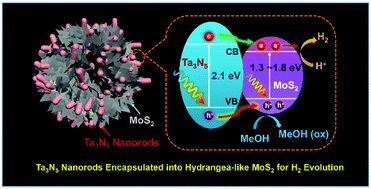Ta3N5 nanorods encapsulated into 3D hydrangea-like MoS2 for enhanced photocatalytic hydrogen evolution under visible light irradiation†
Abstract
Tantalum nitride (Ta3N5) with an appealing band gap (∼2.1 eV) has emerged as a promising catalyst in the photocatalysis field. However, Ta3N5 application in the photocatalytic hydrogen evolution reaction (HER) is limited due to disadvantages such as unsatisfactory separation and transfer of photogenerated carriers. Here we utilize MoS2 as co-catalysts to promote the kinetics of photocatalytic H2 evolution over Ta3N5. The Ta3N5 nanorods were encapsulated into 3D hydrangea-like MoS2 for maximizing the contact areas between Ta3N5 and MoS2 and offering rich active sites. More importantly, spectroscopic analysis and theoretical calculations consistently reveal that the unique interfacial interaction, as well as the matching band alignment between Ta3N5 and MoS2, accelerates the photogenerated charge extraction from Ta3N5 to MoS2, reducing charge recombination losses in Ta3N5. Thus, the optimized Ta3N5/MoS2 hybrid exhibits a substantially enhanced hydrogen evolution rate (56.5 μmol h−1), over 22 times higher than that of pristine Ta3N5. This work may provide a general strategy to overcome the low photocatalytic activity of nitrides for hydrogen evolution.



 Please wait while we load your content...
Please wait while we load your content...